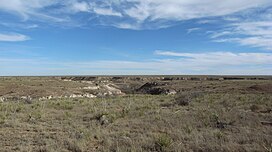| Western short grasslands | |
|---|---|
 Canyon in the shortgrass prairie of Buffalo Lake National Wildlife Refuge | |
 | |
| Ecology | |
| Realm | Nearctic |
| Biome | Temperate grasslands, savannas, and shrublands |
| Borders | |
| Bird species | 245 [1] |
| Mammal species | 107 [1] |
| Geography | |
| Area | 435,200 km2 (168,000 sq mi) |
| Country | United States |
| States | |
| Climate type | Cold semi-arid (BSk) |
| Conservation | |
| Habitat loss | 30.5% [1] |
| Protected | 5% [1] |
The Western short grasslands is a temperate grassland ecoregion of the United States.